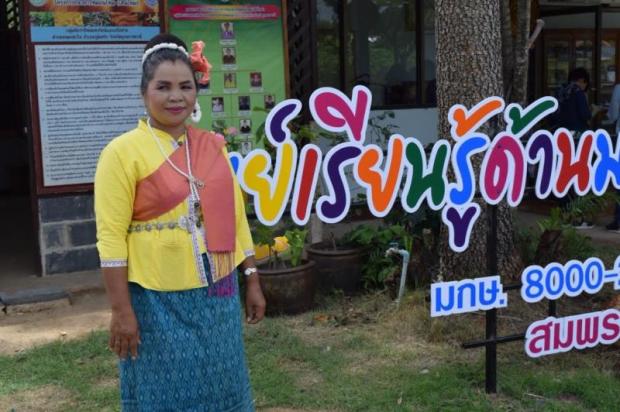
Ban Sompornrat has become well-known for naturally dyed silks and traditional Thai silk weaving. The village is located in Buntharik district, some 85 kilometres from Ubon Ratchathani city.
The village's fame began after a group of female villagers humbly offered their handwoven silk products to Queen Sirikit when Her Majesty visited Ban Khon Pan School in tambon Kho Laen on Nov 16, 1994.
Her Majesty appreciated the silk's beauty and unique texture, and granted the villagers funding to continue their work as well as accepting them as members of the Silapacheep ("artistic profession") project.
The Queen has long provided villagers all over the country with training in the skills of traditional craftsmanship. Her travels around Thailand inspired the project.
She interacted with numerous people who were suffering across the country and sought a sustainable way to help them. The project was founded in 1976 to help rural families earn additional income by providing financial assistance and expert guidance, at no cost, to craftsmen all over Thailand, such as the weavers of yan lipao basketry in the far South, hill tribe silversmiths in the North and mudmee silk fabric weavers upholding traditional patterns in the Northeast.
The Queen also set up two main multi-craft training centres. One compound is in Chitralada Palace in Bangkok. and the other, built in 1980, is at Bang Sai, Ayutthaya province. The Queen has for decades taken a role in promoting the crafts both through her travels and by using the products personally.
Daoruang Yodsamma, 52, chief of Silapacheep Centre at Ban Sompornrat, said the Silapacheep project helps generate more income for the villagers, who normally just grow rice.
Ban Sompornrat's Silapacheep Centre has 522 villager members from five districts within Ubon Ratchathani province. Of the total, 90 members are from Ban Sompornrat.
Famous products include mudmee silk fabric in old patterns, silk fabric in peacock patterns and natural dyed silk.
Ban Sompornrat uniquely crafts muk jok dao ("whale silk fabric") sarongs, which cost up to 5,000 baht per metre.
According to Mrs Daoruang, the Queen's project has not only helped turn around the plight of rural ladies, but has also preserved traditional wisdom.
The project's members earn more than 20,000 baht per month a marked increase from under 5,000 baht a month in the past.
Apart from silk fabrics, Ban Sompornrat makes silk-based products such as blankets and bags and exports silk fabrics and silk cocoons to Japan.
The village started exporting silk cocoons to Japan two years ago for 250 baht a kilogramme, sending a total of 700kg a year.
The village plans to increase silk cocoon exports to 1,000kg this year.
"Japanese buyers want more silk cocoons because of the good quality of local silk here, but we could not fulfil the purchase orders because our production depends on weather and some villagers prefer to weave silk sarongs instead of selling the silk cocoons," Mrs Daoruang said.
Japan uses Thai silk cocoons to make blankets and handbags.
Mrs Daoruang said Ban Sompornrat established a silk fabric bank early last year with initial funding of 6,000 baht mobilised from 90 members within the village.
The bank buys silk fabrics from the villagers and sells them at trade fairs, especially the One Tambon One Product (Otop) event.
The Queen Sirikit Department of Sericulture recently granted 30,000 baht to the bank.
Dat Bunterm, 61, former headman of Ban Sompornrat, said the bank has 300,000 baht in funds and paid each member a dividend of 16,300 baht in 2017.
Mr Dat said Ban Sompornrat recently set up a learning centre for sericulture and a production process for silk fabric.
Ban Sompornrat officially opened an Otop Tourism Village on Aug 17.
Monchai Chantharothorn, chief of Buntharik district, said Ban Sompornrat furnishes outstanding silk fabrics and grows organic mulberry, which is an attraction for visitors.
The community may need to develop more Otop products such as handicrafts from silk, mulberry juice, mulberry jam and other products, Mr Monchai said.



